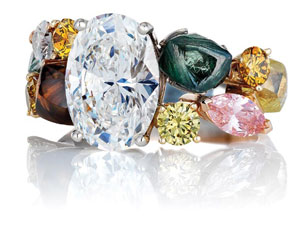


The Gemological Institute of America defines a macle as a twinned diamond crystal. It is composed of two opposing parts, each with the same crystal shape. The two parts are oriented 60 degrees or 180 degrees from each other, so the macle looks like a flattened triangle. Put simply, a macle is a specific type of rough diamond used to produce jewellery that is singular and sophisticated. It has a flat, triangular shape. Macles occur naturally in the earth and are different from the more classic octahedral rough diamonds. Today, macles are often turned into fancy cuts such as trilliants or hearts.
A macle may not be everybody’s cup of tea, but it has a quiet, understated luxury. One needs to really know one’s diamonds in order to appreciate the kind of elegance a macle brings to jewellery. Today, macles are found in every mine all over the world. Miners say they are rare, and it feels good to discover them, especially if they have rolled on for millennia along a riverbed and acquired a natural shiny patina.
Reasons why they are gaining popularity Although macles have been around for a long time, their use in fashion and fine jewellery is a somewhat recent phenomenon. Jewellers of repute say that these twinned diamond crystals have been part of the jewellery landscape for thousands of years, and were probably first used in jewellery in India about 2,500 years ago when diamonds were discovered in Golconda. Of late, discerning jewellery lovers are taking to macles, as they prefer rough diamonds in their natural state, a trend that is also catching on with brides. Raw diamond rings, especially, are catching the fancy of many consumers, especially those who look for something different, something non-blingy, yet tasteful and elegant. Macles are fast becoming part of an overall trend to celebrate things as the earth made them, rather than after a lot of human intervention.


Besides, using macles also results in more labour. This is because instead of resorting to ready-made components that are created to standard sizes, a setting has to be created by hand for each individual stone. The extra labour that is often required while working with macles also affects the price of a finished piece. In general, uncut diamonds cost less than cut diamonds of similar quality and size. But because uncut stones require a custom setting, this may result in an elevated price for the jewellery item.
As with all diamonds, the price of jewellery using macles also varies with the quality of the stones. It is not often that large macles are discovered, but when they are, they can become the centrepiece of a piece of jewellery.
All in all, macle diamond jewellery is different, looks different and feels different. It is not for everyone -- it does not have the brilliance of cut diamonds. But it is edgy, different, out of the ordinary, and comes with a quiet beauty. If you can appreciate these qualities, then macle diamond jewellery is definitely for you.
Follow DiamondWorld on Instagram: @diamondworldnet
Follow DiamondWorld on Twitter: @diamondworldnet
Follow DiamondWorld on Facebook: @diamondworldnet
